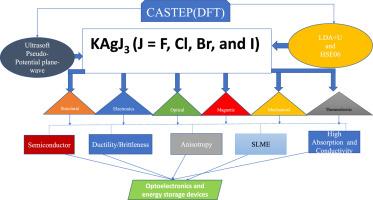Enhancing physical characteristics of the narrow bandgap of perovskite KAgJ3 (J = F, Cl, Br, and I) materials for optoelectronics and energy storage applications
IF 5.7
3区 材料科学
Q2 MATERIALS SCIENCE, MULTIDISCIPLINARY
引用次数: 0
Abstract
Bandgap engineering assists the scientific community in designing semiconducting nanomaterials according to their preferred specifications for energy applications. Herein, the perovskite KAgJ3 (J = F, Cl, Br, and I) compound depends on the DFT (CASTEP) code by using GGA-PBE approximations, is investigated. The structure of the KAgJ3 compounds is cubic in nature, with space group 221 (Pm3m) and 5 atoms per unit cell. The structural and thermodynamic stability is confirmed via formation energy and tolerance factor of KAgJ3 (J = F, Cl, Br, and I), which are (0.77, 0.76, 0.75, 0.75) and (-3.864, -2.952, -2.655, -2.345) eV/atoms, respectively. With the application of elemental substitutions, the bandgap is decreased from 2.25 eV to 0.48 eV, as discovered through the electronic properties. According to the Born stability (C11> C12, C44>0, C11 + 2C12>0), Pugh’s ratio (2.56 to 7.19), Poison’s ratio (0.33 to 0.43), and modulus (B, G, E) GPa criteria, KAgJ3 are stable, ductile, and hard. Thermodynamic parameters of the compounds KAgJ3 are also investigated as Debye temperature (234.211, 185.089, 147.910, 73.246)K, sound velocity (2032.907, 1896.366, 1576.479, 846.187) m/s, and compressibility (0.019, 0.044, 0.041, 0.057) 1/GPa. The compounds' hypothetical dielectric function (22.81, 15.86, 26.17, and 17.39), loss function (5.29, 2.33, 1.49, and 2.19), absorption (228,876.62 cm-1, 156,479.91 cm-1, 217,986.11 cm-1, and 197,013.99 cm-1), refractive index (4.76, 4.01, 4.93, and 4.17), conductivity (11.66, 15.43, 10.86, and 6.80 eV), and reflectivity (0.44, 0.37, 0.44, and 0.33) are used to analyze their optical transitions. Various thermodynamic parameters are investigated based on temperature, including energy, heat capacity, and Debye temperature. According to investigations of optical properties under elemental substitutions, the compound’s optical traits shifted from ultra-violet to the visible region, which indicates that it absorbs as well as emits light at longer wavelengths due to its reduced bandgap, making the said material appropriate for optoelectronics and energy storage devices.

提高钙钛矿KAgJ3 (J = F, Cl, Br, and I)材料在光电子和储能应用中的物理特性
带隙工程帮助科学界根据他们的首选规格设计半导体纳米材料用于能源应用。本文利用GGA-PBE近似研究了钙钛矿化合物KAgJ3 (J = F, Cl, Br, and I)依赖于DFT (CASTEP)编码的性质。KAgJ3化合物的结构为立方结构,空间基为221 (Pm3m),每晶胞有5个原子。KAgJ3 (J = F, Cl, Br, I)的形成能和容差因子分别为(0.77,0.76,0.75,0.75)和(-3.864,-2.952,-2.655,-2.345)eV/原子,证实了KAgJ3的结构和热力学稳定性。通过电子性质发现,元素置换后,带隙从2.25 eV减小到0.48 eV。根据Born稳定性(C11> C12、C44>0、C11 + 2C12>0)、Pugh比(2.56 ~ 7.19)、Poison比(0.33 ~ 0.43)和模量(B、G、E) GPa标准,KAgJ3具有稳定、延展性和硬性。KAgJ3的热力学参数为德拜温度(234.211、185.089、147.910、73.246)K,声速(2032.907、1896.366、1576.479、846.187)m/s,压缩系数(0.019、0.044、0.041、0.057)1/GPa。利用这些化合物的介电函数(22.81、15.86、26.17和17.39)、损耗函数(5.29、2.33、1.49和2.19)、吸收函数(228,876.62 cm-1、156,479.91 cm-1、217,986.11 cm-1和197,013.99 cm-1)、折射率(4.76、4.01、4.93和4.17)、电导率(11.66、15.43、10.86和6.80 eV)和反射率(0.44、0.37、0.44和0.33)来分析它们的光学跃迁。研究了基于温度的各种热力学参数,包括能量、热容量和德拜温度。根据元素取代下的光学性质研究,该化合物的光学特性从紫外线区转移到可见光区,这表明由于其带隙减小,它吸收和发射更长的波长的光,使所述材料适合于光电子和能量存储设备。
本文章由计算机程序翻译,如有差异,请以英文原文为准。
求助全文
约1分钟内获得全文
求助全文
来源期刊

Materials Research Bulletin
工程技术-材料科学:综合
CiteScore
9.80
自引率
5.60%
发文量
372
审稿时长
42 days
期刊介绍:
Materials Research Bulletin is an international journal reporting high-impact research on processing-structure-property relationships in functional materials and nanomaterials with interesting electronic, magnetic, optical, thermal, mechanical or catalytic properties. Papers purely on thermodynamics or theoretical calculations (e.g., density functional theory) do not fall within the scope of the journal unless they also demonstrate a clear link to physical properties. Topics covered include functional materials (e.g., dielectrics, pyroelectrics, piezoelectrics, ferroelectrics, relaxors, thermoelectrics, etc.); electrochemistry and solid-state ionics (e.g., photovoltaics, batteries, sensors, and fuel cells); nanomaterials, graphene, and nanocomposites; luminescence and photocatalysis; crystal-structure and defect-structure analysis; novel electronics; non-crystalline solids; flexible electronics; protein-material interactions; and polymeric ion-exchange membranes.
 求助内容:
求助内容: 应助结果提醒方式:
应助结果提醒方式:


